An ‘boks amach’:* the Irish Anti-Apartheid Movement
Published in 20th-century / Contemporary History, Features, Issue 4 (Jul/Aug 2006), Volume 14
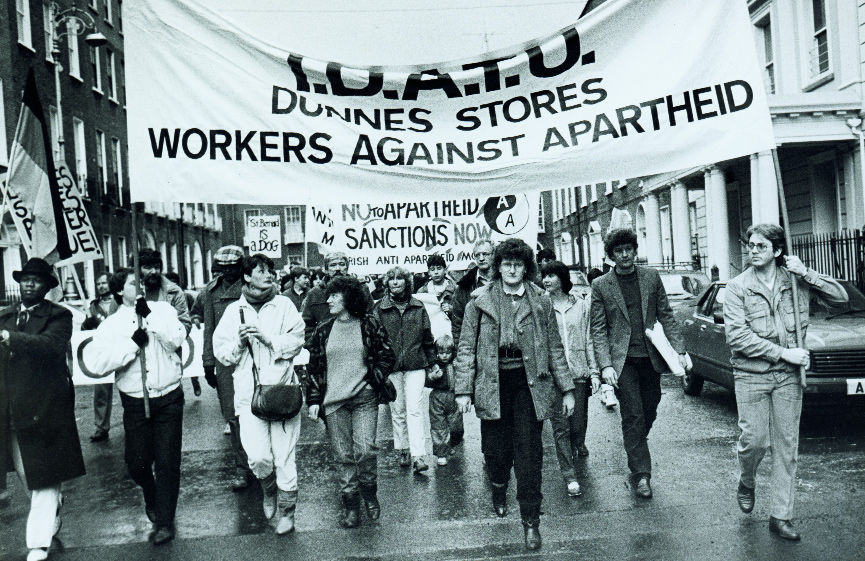
Dunnes Stores strikers on an Irish Anti-Apartheid Movement national march through Dublin, November 1986. (An Phoblacht)
*From an anti-apartheid placard protesting at the 1970 visit of the Springboks rugby team to Lansdowne Road.
On Thursday 19 July 1984, Mary Manning, a cashier at Dunnes Stores in Dublin’s Henry Street, told a customer that she would not check out any Outspan grapefruits. A few minutes later she confirmed with her manager that she would not sell any South African fruit that day or any other. She was upholding a decision made by her trade union, the Irish Distributive Administrative Trade Union (IDATU). Three months earlier the union had decided that its members would not handle South African goods. Mary Manning was supported by her shop steward, Karen Gearon, who walked out of the store with her. Most of the workers at Dunnes in Henry Street went on strike that day, and eight of them joined Mary Manning and Karen Gearon thereafter. They would stay on strike for the next two and a half years, surviving on strike pay of £21 a week, returning to work only after the Irish government prohibited the sale of South African fruit and vegetables in Irish stores.
Dunnes strike high-water mark of Irish Anti-Apartheid Movement
The protest by Mary Manning and her colleagues was exceptional—they were joined only by a single worker at another store—and the Irish Congress of Trade Unions withheld even rhetorical backing for over a year. Nor at first did their actions appear to engender much sympathy among members of the public. The strikers established a picket line outside the store entrance, attracting derision and abuse from shoppers. People called the strikers ‘nigger-lovers’ and even spat at them. Two of the strikers received a visit from the Special Branch.
Public perceptions of the strike were to change, however. There was growing support for the movement, partly as a consequence of a meeting in London in December between the strikers and Archbishop Desmond Tutu while he was on his way to collect the Nobel Peace Prize in Oslo.
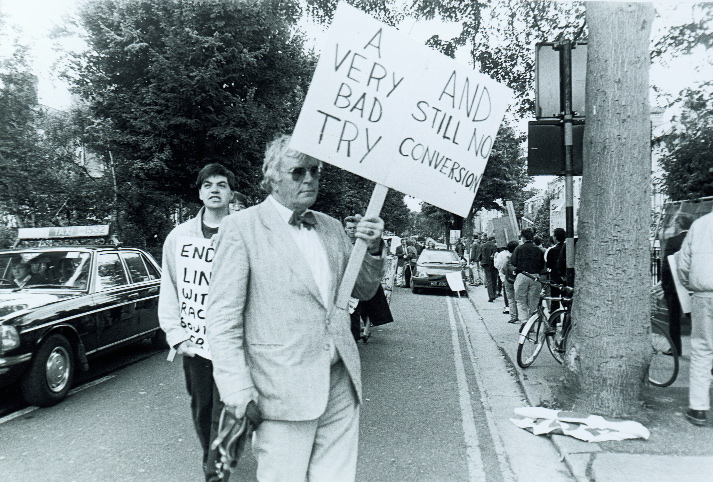
Tiernán MacBride, son of Seán, grandson of Major John, pickets outside the Irish Rugby Football Union’s headquarters in September 1989 in protest at plans for a tour of South Africa. Another grandson, South African Robert, was active in the ANC’s armed struggle against the apartheid regime, epitomising the intimacy of the Irish/South African relationship. (An Phoblacht)
Public interest quickened when the strikers’ cause was taken up by parliamentarians as well as by the Catholic Church. After statements by Bishop Eamon Casey and the Conference of Religious Superiors many priests stopped shopping at Dunnes Stores. Strike supporters participated in the protest in more assertive ways as well, filling their trolleys and leaving them at the check-out stands, a tactic that was later borrowed by protesters in South Africa. Dunnes remained obdurate, however, continuing to stock South African products. Mary Manning’s decision to comply with her union’s injunctions on 19 July 1984 was influenced by a history of tense relations between the shop workers and their supervisors. Other firms had responded to the IDATU resolution by agreeing to join the boycott at its inception.
In response to an invitation from Archbishop Tutu, the strikers planned a visit to South Africa, raising £6000 for their fares, a considerable sum. On arrival in Johannesburg they were denied entry into South Africa. During their return journey they were escorted off the plane in London to attend a press conference assembled for their reception. By now there was considerable public sympathy for the strikers.
The Dunnes strike represented the high-water mark of the Irish Anti-Apartheid Movement’s public influence. By 1984 the IAAM had existed for twenty years. This was not the first time it had inspired assertive activism. In January 1970, for example, several hundred opponents of the Springboks rugby side had clashed with police while demonstrating outside the hotel accommodating the visiting players. Several thousand protestors assembled outside Lansdowne Road the following day. They did not halt the game, however, nor did they appear to have significantly affected the attitudes of Irish rugby officials or supporters. More than a decade later, in 1981, an Irish team toured South Africa, the Irish Rugby Football Union apparently undeterred by sharp condemnations from politicians across the political spectrum. The IRFU only decided officially to cease planning South African fixtures in October 1989, just a couple of years before the ending of the international boycott of South African sport.
The attitudes of members of the rugby fraternity notwithstanding, according to Nelson Mandela the Irish ranked with the Dutch and the Scandinavians as leading Western nations in the anti-apartheid solidarity movement. Mandela was visiting Ireland at the time he made this remark, but the observation was not just prompted by his habitual courtesy to his hosts. Anti-apartheid organisations had established themselves in a range of Western countries, beginning in Britain in 1959. Very few would match the Irish group’s success in enlisting support within the political establishment, even at quite an early stage. The Dunnes strike suggests that, in its third decade, what had begun as a pressure group was beginning to develop into a more broadly appealing social movement. Mary Manning and her colleagues did not belong to the Irish Anti-Apartheid Movement and when they began their protest they were only vaguely informed about South African issues. Why was anti-apartheid to become a popular cause in Ireland?
Ireland and South Africa
Historic connections between South Africa and Ireland may have helped to engender interest in South Africa, at least within élite circles. Sixty thousand people of Irish descent lived in South Africa by the 1960s, mostly the descendants of immigrants who had arrived between 1880 and 1910. Irish emigration to South Africa dwindled thereafter, as the demand for skilled artisans slackened. Between 1899 and 1902, 30,000 Irish soldiers had fought in the Anglo-Boer War in the Imperial forces. The first Roman Catholic bishop arrived in South Africa from Ireland in 1834. The largest single group of Catholic Irish missionaries worked in South Africa, and Irish churchmen remained prominent in the Roman Catholic hierarchy in South Africa throughout the apartheid era. The South African Catholic Church retained strong links with Irish religious institutions. Both Archbishop Denis Hurley and Archbishop Owen McCann were the sons of Irish immigrants. Trained as a novice in Dublin during the 1930s in the Oblates of Mary Immaculate, Archbishop Hurley was to become a vigorous critic of the South African authorities. In 1984 he was arrested and charged with police defamation, and his house was subsequently petrol-bombed.
As with the development of the Roman Catholic Church in the two countries, the history of Irish and South African republicanism is quite closely intertwined. Arthur Griffith, the founder of Sinn Féin, returned to Ireland in 1888 after working as a journalist and mine-worker in the Transvaal. A strong pro-Boer movement existed among nationalists in Ireland during the 1899–1902 war, and in South Africa Irish immigrants assembled two brigades that fought under Afrikaner command against the British. Tactics used by both sides in the Irish War of Independence were shaped by Anglo-Boer War experience. In the 1922 Rand Revolt, an insurrectionary protest against the allocation of skilled work to Africans, the insurgents included an Irish commando unit.
Meanwhile, between the two world wars the memory of historic solidarity helped to nurture friendly relations between Free State politicians and the former Boer generals who now led the South African government. Ireland’s own dominion status was partly modelled on South African precedent, and General Jan Smuts played an active role in the Anglo-Irish settlement. General Louis Botha, the Union of South Africa’s first prime minister, was married to a descendant of Robert Emmett.
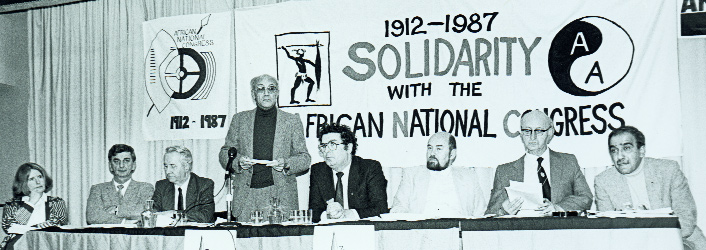
Catherine Bulbulia (Fine Gael), Niall Andrews (Fianna Fáil), Donal Nevin (Irish Congress of Trade Unions), Reg September (African National Congress), John Hume (SDLP), Ruairi Quinn (Labour Party), Tomás MacGiolla (Workers’ Party) and Kader Asmal (IAAM) share a platform to celebrate the 75th anniversary of the African National Congress. From the start Asmal’s intention was that the Irish Anti-Apartheid Movement should aim to acquire broad appeal, led as much as possible by well-known local personalities. (An Phoblacht)
South African diplomatic support for Ireland was especially important during the 1930s, when South Africa backed Irish positions at inter-dominion trade negotiations. Afrikaner nationalist support for Irish neutrality during World War II helped to explain the initially sympathetic stance adopted by the Irish government after the National Party took power in 1948.
Seán MacBride, Ireland’s minister for external affairs from 1948 to 1951, was the son of Major John MacBride, executed for his part in the 1916 Rising and a veteran of the Anglo-Boer War, in which he had commanded the Irish Transvaal Brigade, holding a commission from the South African Republic. MacBride was later one of the most influential public figures associated with the IAAM, but in the early 1950s, like many other Irish nationalists, he was warmly predisposed towards Pretoria. His later opposition to apartheid was partly the consequence of a history of emotional engagement with Southern Africa prompted by his own family history.
Formation
The impetus to form an anti-apartheid movement in Ireland was external in origin, however. The IAAM was initially an extension of the British movement. It was founded by Kader Asmal shortly after his arrival in Ireland to take up an appointment as a law lecturer at Trinity College. Asmal was the son of a shopkeeper in a small rural town, Stanger, twenty miles or so north of Durban. He was a third-generation South African, a member of the Indian community that had been established in Natal as a workforce for the sugar plantations during the nineteenth century. He qualified as a teacher in the early 1950s and worked in various sugar company towns while taking correspondence courses for a university degree. His first contact with politics was a consequence of his opposition while a schoolboy to the segregation of cricket clubs. After obtaining entry to the London School of Economics he travelled to London, where in 1959 he shared a house with other South Africans with African National Congress (ANC) connections, and in conjunction with British students and members of Christian Action and the Labour Party he helped to launch a boycott of South African goods. The organisational network created to promote the boycott became the British Anti-Apartheid Movement (AAM), constituted at the beginning of 1960.
The AAM claimed its first major triumph in 1963 with the cessation of British arms sales to Pretoria. The British Anti-Apartheid Movement benefited from public reaction to the Sharpeville massacre, but its influence was also attributable to long-standing associations between the ANC and well-connected anti-colonial lobbies in London. Thousands of South African political exiles would make their home in London and elsewhere in Britain, and the British AAM supplied one obvious focus for their own activism. The Irish movement did not have a comparable social base, nor could it exploit existing international associations between the ANC and a local leftist community. Kader Asmal and his wife Louise held the first meeting of the Irish Anti-Apartheid Movement in their own living-room, and throughout its history the IAAM’s committee would meet every other Monday night at the Asmals’.
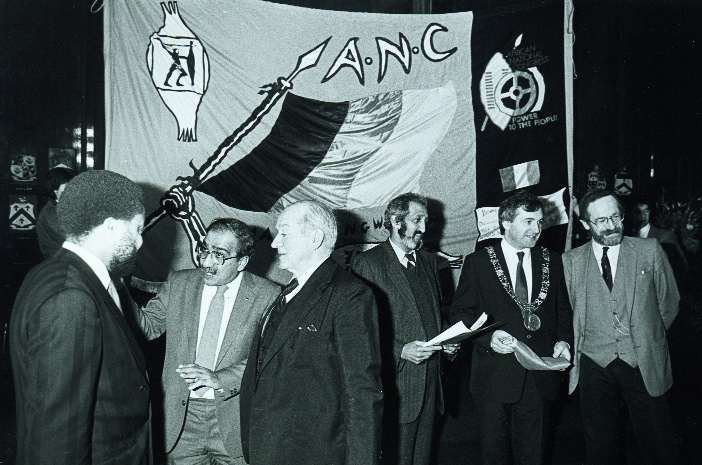
Lord Mayor Bertie Ahern, flanked by actor Ger O’Leary (right) and ANC representative Aziz Pahad (left), hosts a celebration of the ANC’s 75th anniversary in Dublin’s Mansion House in December 1986. To the left is the Nigerian ambassador in conversation with Kader Asmal and actor Cyril Cusack. (An Phoblacht)
The movement’s success was largely a consequence of Kader Asmal’s own energy and commitment, as well as his growing professional distinction. He arrived in Dublin as a qualified British barrister. He obtained a Dublin MA in 1966 and became a barrister at law at King’s Inns in Dublin ten years later. Early involvement in Irish civil liberties and civil rights campaigning, both in the Republic and in the North, helped to foster empathy for the anti-apartheid cause among Irish nationalist politicians. For example, in 1966 Asmal was present at the inaugural meeting in Belfast of the Northern Ireland Civil Rights Association, appearing on the programme as a speaker. Asmal’s own students were to represent another channel of influence—his first law classes at Trinity included Mary Robinson, with whom he later formed the Irish Council for Civil Liberties. Mary Robinson remained a sponsor of the IAAM after her election as president in 1990. Asmal’s intention was that, like the British organisation, the Irish Anti-Apartheid Movement should aim to acquire broad appeal, led as much as possible by well-known local personalities. The small scale and social intimacy of Ireland’s public life worked to his advantage.
A liaison group between the Irish Congress of Trade Unions (ICTU) and the IAAM facilitated access to the labour movement. Local branches and school-based associations helped the organisation to build its public following. Louise Asmal coordinated a network within the IAAM branch membership to serve as letter-writers for the International Defence and Aid Fund. As an organisation proscribed in South Africa, the IDAF could not send money into South Africa directly, and it relied on local volunteers to write to the dependants of political prisoners, sending them money purportedly as private gifts. The IAAM was active in Northern Ireland as well.
To a greater degree than in Britain, the IAAM’s support base was anchored among Irish trade unionists, and its initial parliamentary connections were strongest with the Labour Party. Donal Nevin, later general secretary of the ICTU, associated himself with the movement from its beginning. From 1969 the IAAM’s following in the Dáil included the Labour Party’s Conor Cruise O’Brien, whose public opposition to apartheid dated back to his condemnation of South African policies at the United Nations Special Political Committee in 1957. Asmal had persuaded O’Brien to accept the chairmanship of the IAAM in 1966 while O’Brien was based at New York University, spending his summer vacations in Ireland.
Asmal’s growing stature at Trinity—he was appointed Dean of Arts in 1980—and his gregariousness helped to ensure that the movement’s affiliations crossed all party lines, from left to right, embracing senior party notables in the Dáil as well as novice politicians in local government. Garret FitzGerald was an early adherent and continued to attend and even preside over IAAM conferences during his term as foreign minister between 1973 and 1977. Current Taoiseach Bertie Ahern joined the IAAM as a Fianna Fáil city councillor. FitzGerald resigned from the IAAM in 1984 after Kader Asmal refused to prohibit Sinn Féin members from joining.
Disagreements about Sinn Féin were also one cause of the rift between Asmal and Conor Cruise O’Brien, which became public in 1986 after O’Brien’s repudiation of the academic boycott and his acceptance of an invitation to lecture at the University of Cape Town. O’Brien had been visiting South African universities since 1979. Local student groups disrupted his classes in both Cape Town and Johannesburg, the first time that there had been any organised opposition inside South Africa to academic visitors. In general, the IAAM was rather successful in persuading Irish intellectuals to support its embargo on cultural contacts of any kind with South Africa, persuading 25 playwrights—including Samuel Beckett and Seán O’Casey—to sign a declaration refusing the performance of their work before segregated audiences. In 1986 South Africans were excluded from an international conference on information-processing in Dublin after trade unions threatened action if they attended.
Impact and consequences
The IAAM’s influence within the Irish political establishment was partly a consequence of its skilful exploitation of traditions of republican affinity between Ireland and South Africa. The British AAM’s emergence out of a trade boycott influenced Kader Asmal in his early emphasis on building relations with Irish trade unions. Shifts in Irish society also helped the movement, especially during the 1980s, as its following expanded on university campuses and within schools. In 1974 the inception of an Irish programme of development aid reflected growing prosperity and an increasingly export-oriented economy. As Ireland’s contacts with the developing world proliferated, its relations with Pretoria cooled. The association of a succession of important Irish diplomats and foreign policy-makers with the IAAM was not coincidental.
What was the impact of the Irish Anti-Apartheid Movement? Until the 1980s it failed to achieve definite changes in official policies. Mary Manning and her colleagues, as well as trade unionists more generally, could take the credit for Ireland’s announcement in December 1986 that the government would halt South African food imports, about half the total of South African imports into the country. The Electricity Supply Board stopped buying South African coal, though imports to private customers continued and mobilising trade union backing for the coal boycott remained an IAAM priority. In 1986 the Irish government closed its tourist office in Johannesburg. During the 1970s and 1980s increasing numbers of Irish sportsmen, entertainers and artists held back from visiting South Africa as a consequence of the IAAM’s embargo. Trinity College and University College Dublin refused to allow its staff leaves of absence to travel to South Africa, a policy also adopted by RTÉ.
Overall, the Irish contribution to South Africa’s growing international isolation, though significant because of the extent to which it reflected political commitment within Ireland, was hardly decisive. Trade between the two countries represented a small share of both countries’ imports and exports.
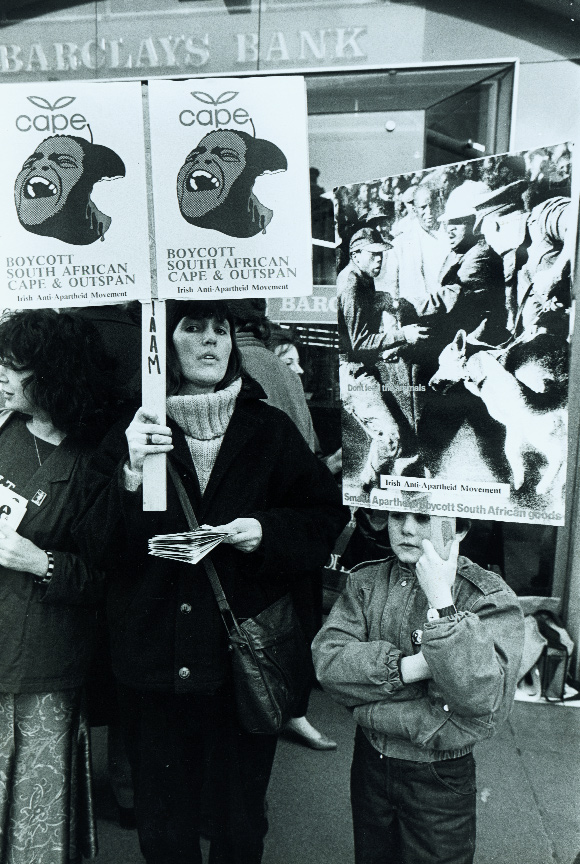
An IAAM picket outside Barclays Bank, Grafton Street, Dublin, in March 1986. While the Irish contribution to the fall of apartheid was hardly decisive, to a considerable degree modern South African democracy is a product of such international solidarity. (An Phoblacht)
Certainly, more generally, the sanctions movement did help to end apartheid: worries about the long-term future of a South African economy deprived of markets and capital were a key consideration for President F. W. de Klerk in releasing Nelson Mandela. The Irish government’s willingness to impose restrictions on South African trade was unusual among European states and was important in shaping European Community policies. Sporting isolation certainly affected white South African morale, especially after the end of foreign rugby tours following a ban announced by the International Rugby Board in 1984.
A more important result of Irish opposition to apartheid may have been its impact upon the black South African political leadership. The degree to which South African leaders committed themselves to racial reconciliation during the negotiations and the extent to which they have maintained that commitment are very substantially the consequence of international solidarity for their cause. Support in Western countries for the struggle against apartheid represented a key incentive in the ANC’s retention of a secular, open, non-racial vision of citizenship.
Kader Asmal himself was to play a key role in both Mandela’s government and its successor, first as minister for water affairs and later as minister for education. Asmal was also a major contributor to the ANC’s acceptance of a liberal constitutionalism, joining the organisation’s negotiating team shortly after his return to South Africa in 1990. In his second career as a South African politician Asmal continued to be influenced by his Irish experience, citing Irish constitutional legal precedents and the experience of rural electrification in the 1920s as sources of inspiration.
Kader Asmal’s case is not exceptional: in Britain and Ireland, the United States and Europe, anti-apartheid movements fostered contact between communities of South African exiles and the larger societies that accommodated them. As a consequence, South African exiles returned to their home country substantially influenced by the political values and conventions of those societies. To a considerable extent, modern South African democracy is a product of the experience of international solidarity.
Tom Lodge is Professor of Peace and Conflict Studies at the University of Limerick.
Further reading:
D.H. Akenson, Occasional papers on the Irish in South Africa (Grahamstown, 1991).
C. Gurney, ‘A great cause: the origins of the British Anti-Apartheid Movement’, Journal of Southern African Studies 26 (1) (2000).
B. Laffan, Ireland and South Africa: Irish government policy in the 1980s (Dublin, 1988).
D. Scher, ‘The Irish Anti-Apartheid Movement’, in D. McCracken (ed.), Irish–South African relations in modern times, vol. 2 (Durban, 1996).
















